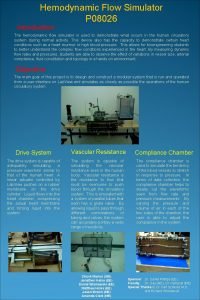Hemodynamic Flow Simulator P 08026 Introduction The hemodynamic

- Slides: 1

Hemodynamic Flow Simulator P 08026 Introduction The hemodynamic flow simulator is used to demonstrate what occurs in the human circulatory system during normal activity. This device also has the capacity to demonstrate certain heart conditions such as a heart murmur or high blood pressure. This allows for bioengineering students to better understand the complex flow conditions experienced in the heart. By measuring dynamic flow rates and pressures, students are able to observe the effect of variations in vessel size, arterial compliance, fluid constitution and topology in a hands on environment. Objective The main goal of this project is to design and construct a modular system that is run and operated from a user interface on Lab. View and simulates as closely as possible the operations of the human circulatory system. Drive System Vascular Resistance The drive system is capable of adequately simulating a pressure waveform similar to that of the human heart. A linear actuator controlled by Lab. View pushes on a rubber membrane on the drive cylinder. Liquid flows into the heart chamber, compressing the actual heart membrane and forcing liquid into the system. The system is capable of simulating the vascular resistance seen in the human body. Vascular resistance is the resistance to flow that must be overcome to push blood through the circulatory system. This is simulated with a system of parallel tubes that each has a globe valve. By allowing liquid to pass through different combinations of tubing and valves, the system can accurately portray a wide range of resistivity. Chuck Marion (ISE) Jonathon Kelso (EE) Daniel Wisniewski (EE) Matthew Hicks (EE) Jason Brown (ME) Amanda Clark (ME) Compliance Chamber The compliance chamber is used to simulate the tendency of the blood vessels to stretch in response to pressure. In terms of data collection, the compliance chamber helps to steady out the waveforms seen from flow rate and pressure measurements. By varying the pressure and volume of air in each of the two sides of the chamber, the user is able to adjust the compliance in the system. Sponsor: Dr. Daniel Phillips (EE) Faculty: Dr. Day (ME), Dr. Kempski (ME) Special Thanks to Dr. Karl Schwarz M. D. and Richard Wisniewski

